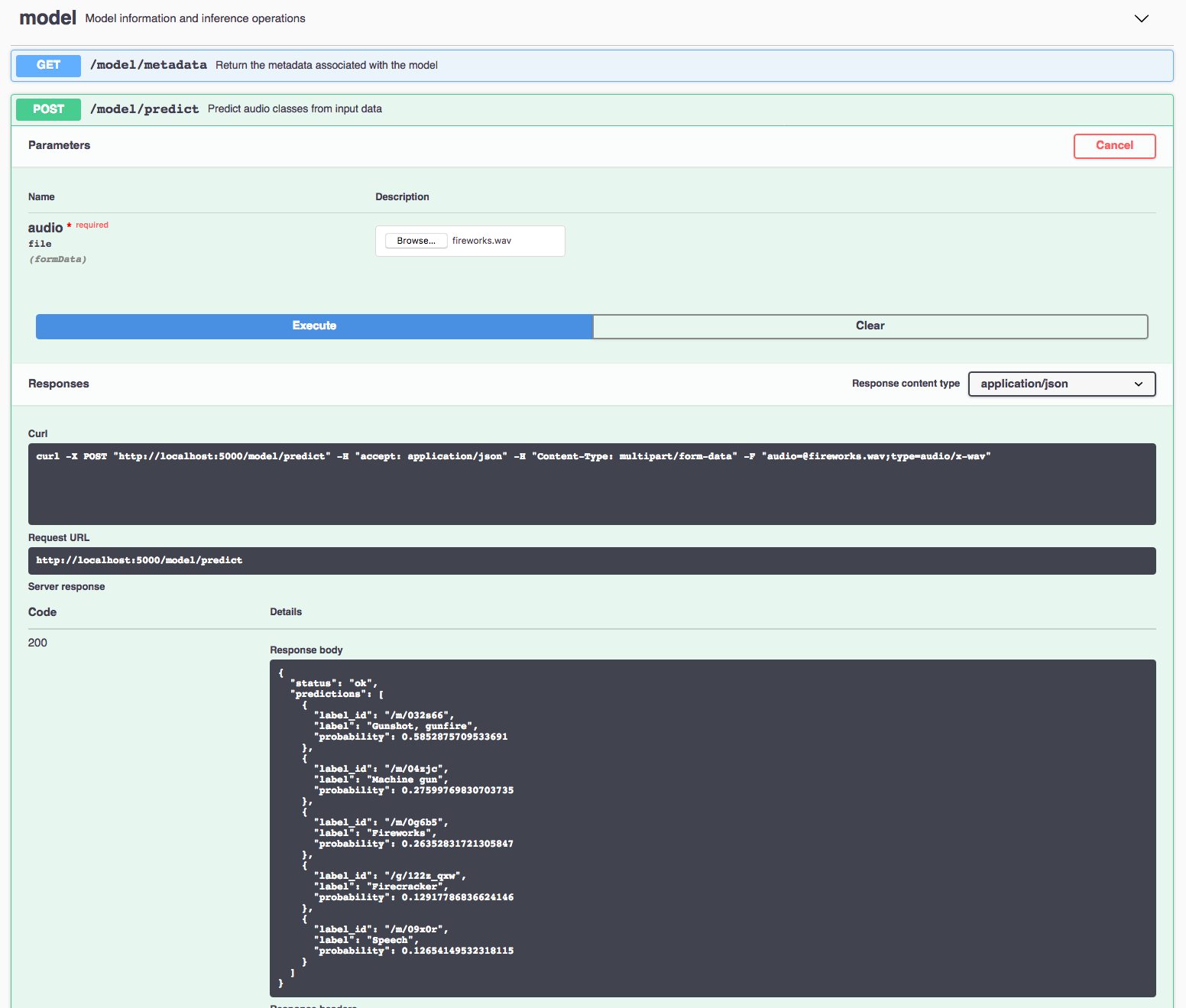This repository contains code to instantiate and deploy an audio classification model. This model recognizes a signed 16-bit PCM wav file as an input, generates embeddings, applies PCA transformation/quantization, uses the embeddings as an input to a multi-attention classifier and outputs top 5 class predictions and probabilities as output. The model currently supports 527 classes which are part of the Audioset Ontology. The classes and the label_ids can be found in class_labels_indices.csv. The model was trained on AudioSet as described in the paper 'Multi-level Attention Model for Weakly Supervised Audio Classification' by Yu et al.
The model has been tested across multiple audio classes, however it tends to perform best for Music / Speech categories. This is largely due to the bias towards these classes in the training dataset (90% of audio belong to either of these categories). Though the model is trained on data from Audioset which was extracted from YouTube videos, the model can be applied to a wide range of audio files outside the domain of music/speech. The test assets provided along with this model provide a broad range.
The model files are hosted on IBM Cloud Object Storage. The code in this repository deploys the model as a web service in a Docker container. This repository was developed as part of the IBM Developer Model Asset Exchange and the public API is powered by IBM Cloud.
| Domain | Application | Industry | Framework | Training Data | Input Data Format |
|---|---|---|---|---|---|
| Audio | Classification | Multi | Keras/TensorFlow | Google AudioSet | signed 16-bit PCM WAV audio file |
-
Jort F. Gemmeke, Daniel P. W. Ellis, Dylan Freedman, Aren Jansen, Wade Lawrence, R. Channing Moore, Manoj Plakal, Marvin Ritter,"Audio set: An ontology and human-labeled dataset for audio events", IEEE ICASSP, 2017.
-
Qiuqiang Kong, Yong Xu, Wenwu Wang, Mark D. Plumbley,"Audio Set classification with attention model: A probabilistic perspective." arXiv preprint arXiv:1711.00927 (2017).
-
Changsong Yu, Karim Said Barsim, Qiuqiang Kong, Bin Yang ,"Multi-level Attention Model for Weakly Supervised Audio Classification." arXiv preprint arXiv:1803.02353 (2018).
-
S. Hershey, S. Chaudhuri, D. P. W. Ellis, J. F. Gemmeke, A. Jansen, R. C. Moore, M. Plakal, D. Platt, R. A. Saurous, B. Seybold et al., "CNN architectures for large-scale audio classification," arXiv preprint arXiv:1609.09430, 2016.
| Component | License | Link |
|---|---|---|
| This repository | Apache 2.0 | LICENSE |
| Model Files | Apache 2.0 | AudioSet |
| Model Code | MIT | AudioSet Classification |
| Test Samples | Various | Samples README |
docker: The Docker command-line interface. Follow the installation instructions for your system.- The minimum recommended resources for this model is 8 GB Memory and 4 CPUs.
To run the docker image, which automatically starts the model serving API, run:
$ docker run -it -p 5000:5000 codait/max-audio-classifier
This will pull a pre-built image from Docker Hub (or use an existing image if already cached locally) and run it. If you'd rather checkout and build the model locally you can follow the run locally steps below.
You can also deploy the model on Kubernetes using the latest docker image on Docker Hub.
On your Kubernetes cluster, run the following commands:
$ kubectl apply -f https://raw.githubusercontent.com/IBM/MAX-Audio-Classifier/master/max-audio-classifier.yaml
The model will be available internally at port 5000, but can also be accessed externally through the NodePort.
A more elaborate tutorial on how to deploy this MAX model to production on IBM Cloud can be found here
Clone this repository locally. In a terminal, run the following command:
$ git clone https://github.com/IBM/MAX-Audio-Classifier.git
Change directory into the repository base folder:
$ cd MAX-Audio-Classifier
To build the Docker image locally, run:
$ docker build -t max-audio-classifier .
All required model assets will be downloaded during the build process. Note that currently this Docker image is CPU only (we will add support for GPU images later).
To run the Docker image, which automatically starts the model serving API, run:
$ docker run -it -p 5000:5000 max-audio-classifier
The API server automatically generates an interactive Swagger documentation page. Go to http://localhost:5000 to load
it. From there you can explore the API and also create test requests.
Note : The input is a 10 second signed 16-bit PCM wav audio file. Files longer than 10 seconds will be clipped so that only the first 10 seconds will be used by the model. Conversely, files shorter than 10 seconds will be repeated to create a clip 10 seconds in length.
Use the model/predict endpoint to load a signed 16-bit PCM wav audio file (you can use the fireworks.wav file located
in the samples folder) and get predictions from the API.
You can also test it on the command line, for example (with the thunder.wav file):
$ curl -F "audio=@samples/thunder.wav" -XPOST http://localhost:5000/model/predict
You should see a JSON response like that below:
{
"status": "ok",
"predictions": [
{
"label_id": "/m/06mb1",
"label": "Rain",
"probability": 0.7376469373703003
},
{
"label_id": "/m/0ngt1",
"label": "Thunder",
"probability": 0.60517817735672
},
{
"label_id": "/t/dd00038",
"label": "Rain on surface",
"probability": 0.5905200839042664
},
{
"label_id": "/m/0jb2l",
"label": "Thunderstorm",
"probability": 0.5793699026107788
},
{
"label_id": "/m/07yv9",
"label": "Vehicle",
"probability": 0.34878015518188477
}
]
}
To run the Flask API app in debug mode, edit config.py to set DEBUG = True under the application settings. You will
then need to rebuild the Docker image (see step 1).
To stop the Docker container, type CTRL + C in your terminal.


